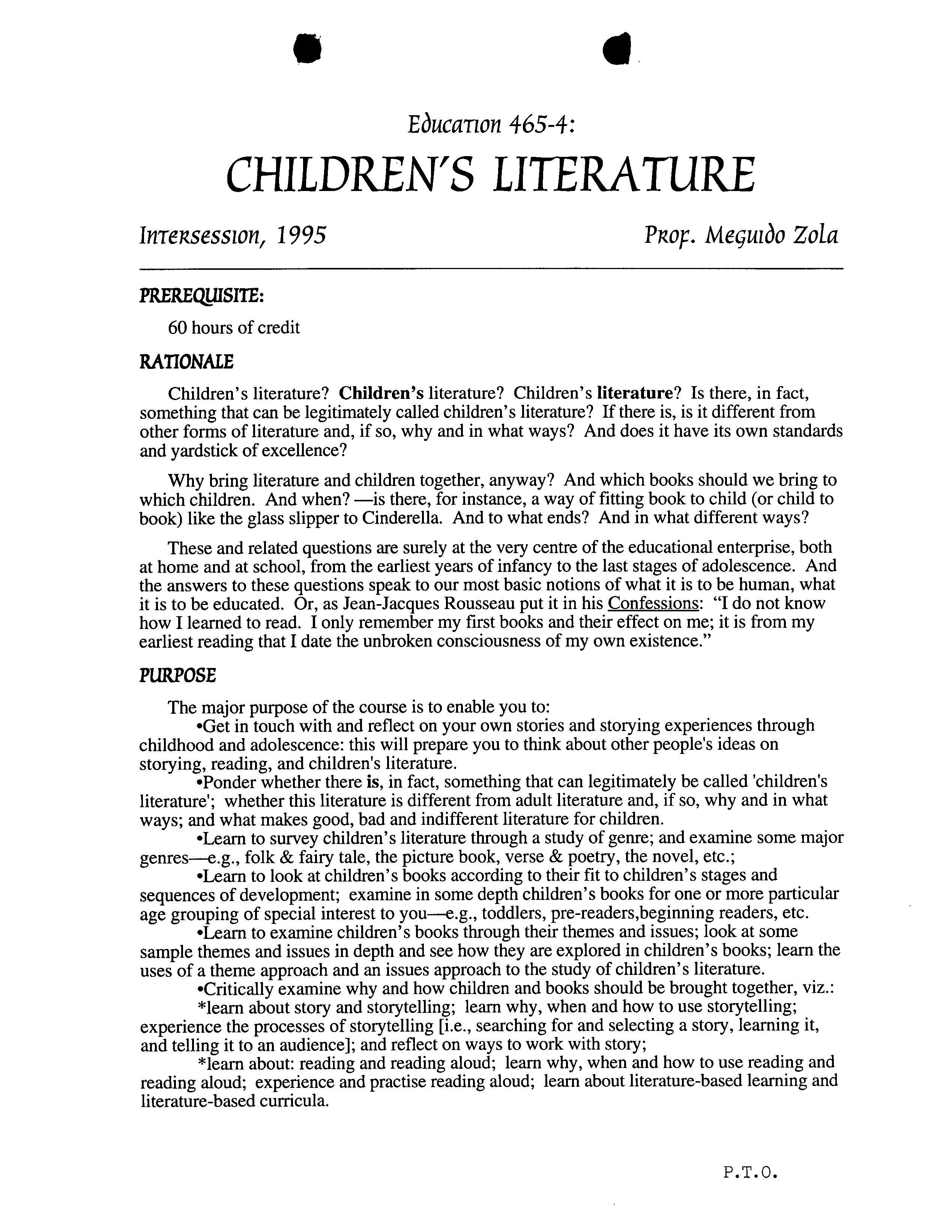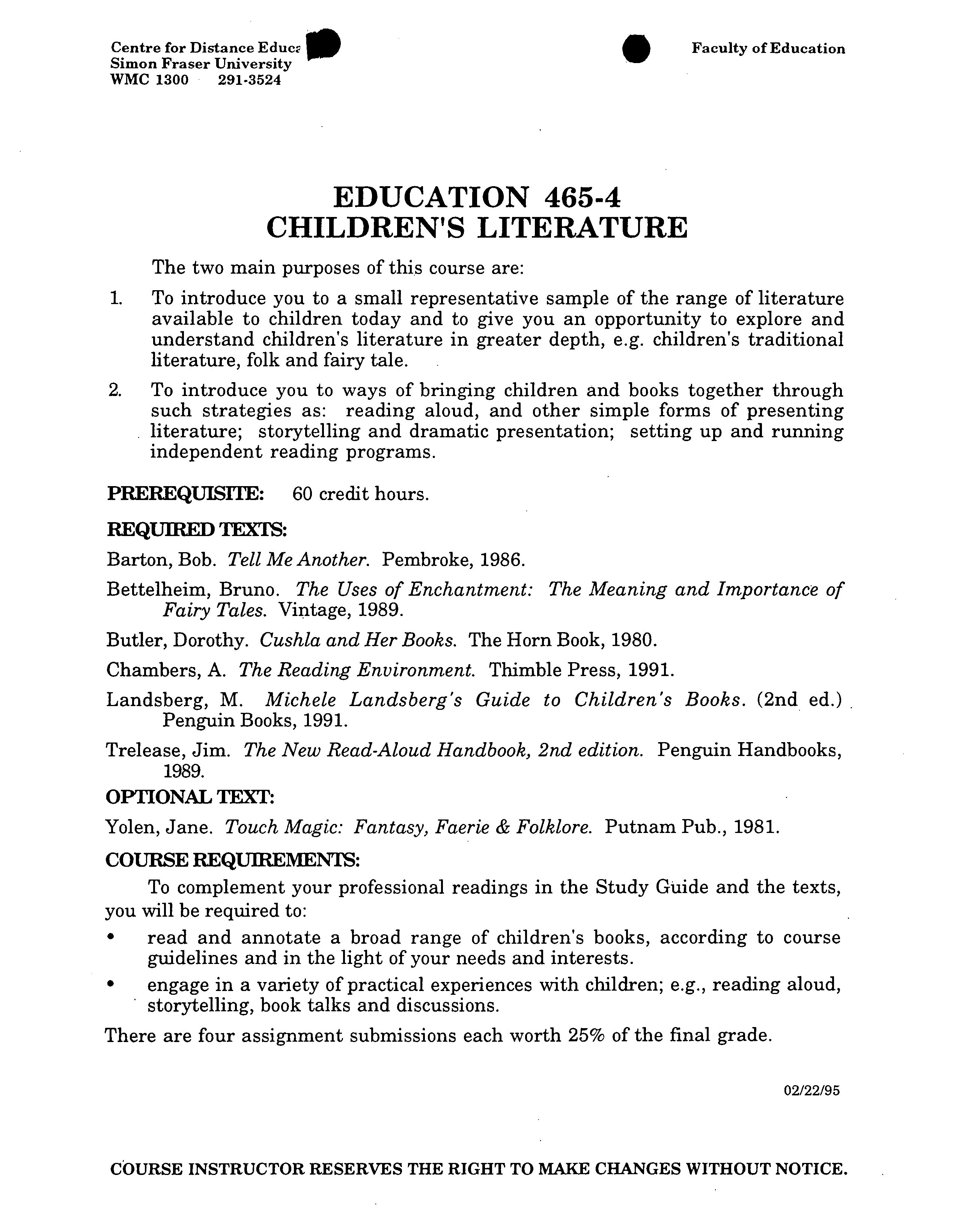S ?
I.
EaucaTlon 465-4:
CHILDREN'S LITERATURE
InTelzsesslon, 1995
?
PizoF. Mequiào ZoLa
PREREQUISITE:
60 hours of credit
RATIONALE
Children's literature?
Children's
literature? Children's
literature?
Is there, in fact,
something that can be legitimately called children's literature? If there is, is it different from
other forms of literature and, if so, why and in what ways? And does it have its own standards
and yardstick of excellence?
Why bring literature and children together, anyway? And which books should we bring to
which children. And when? —is there, for instance, a way of fitting book to child (or child to
book) like the glass slipper to Cinderella. And to what ends? And in what different ways?
These and related questions are surely at the very centre of the educational enterprise, both
at home and at school, from the earliest years of infancy to the last stages of adolescence. And
the answers to these questions speak to our most basic notions of what it is to be human, what
it is to be educated. Or, as Jean-Jacques Rousseau put it in his Confessions: "I do not know
how I learned to read. I only remember my first books and their effect on me; it is from my
earliest reading that I date the unbroken consciousness of my own existence."
PURPOSE
The major purpose of the course is to enable you to:
-Get in touch with and reflect on your own stories and storying experiences through
childhood and adolescence: this will prepare you to think about other people's ideas on
storying, reading, and children's literature.
-Ponder whether there
is,
in fact, something that can legitimately be called 'children's
literature'; whether this literature is different from adult literature and, if so, why and in what
ways; and what makes good, bad and indifferent literature for children.
•
Learn to survey children's literature through a study of genre; and examine some major
genres—e.g., folk & fairy tale, the picture book, verse & poetry, the novel, etc.;
'Learn to look at children's books according to their fit to children's stages and
sequences of development; examine in some depth children's books for one or more particular
age grouping of special interest to you—e.g., toddlers, pre-readers,beginning readers, etc.
-Learn to examine children's books through their themes and issues; look at some
sample themes and issues in depth and see how they are explored in children's books; learn the
uses of a theme approach and an issues approach to the study of children's literature.
-Critically examine why and how children and books should be brought together, viz.:
*learn about story and storytelling; learn why, when and how to use storytelling;
experience the processes of storytelling [i.e., searching for and selecting a story, learning it,
and telling it to an audience]; and reflect on ways to work with story;
*learn about: reading and reading aloud; learn why, when and how to use reading and
reading aloud; experience and practise reading aloud; learn about literature-based learning and
literature-based curricula.
P.T.O.
I
?
4
FORMAT
The course will comprise a range and variety of learning experiences. These include:
individual study, research, and field-work with children; focussed practice of instructional
strategies and procedures, with peer review and feedback; small-group and whole-class
discussion, projects, and presentations; lectures, workshops, and demonstrations.
The course will function as a forum and as a catalyst not only for its own agenda but also
for the work of each individual student as it relates to the goals of the course. Students will
fulfill the general objectives of the course and, in addition, each student will become an expert
in an aspect of the field of his/her choosing in consultation with the instructor.
REQUIREMENTS
The course requirements comprise the following:
'regular class attendance and participation
'completion of readings
'completion of assignments
'demonstration of competency in the fulfilment of selected assignments.
EVALUATION
The completion of course requirements will form the basis for evaluation. The final
evaluating process comprises both self-assessment and the instructor's evaluation.
READINGS
Trelease, Jim.
The New Read-Aloud Handbook.
Penguin. ISBN 0140468811
Chambers, Aidan.
The Reading Environment.
Thimble Press. ISBN
0903355361
Stone, Elizabeth.
Black Sheep and Kissing Cousins.
Penguin. ISBN 0140119779
Barton, Bob & David Booth.
Stories in the Classroom.
Pembroke. ISBN 0921217439
In addition to the required readings, supplementary readings will be recommended to the
class and/or to selected groups and/or individuals at appropriate times, as relevant.
A detailed outline of topics and schedule of readings and other assignments will be made
available at the first class, along with a list of recommended readings.
0 ?
Faculty of Education
Centre for Distance Educat
Simon Fraser University
WMC 1300 ?
291.3524
EDUCATION 465-4
CHILDREN'S LITERATURE
The two main purposes of this course are:
1.
To introduce you to a small representative sample of the range of literature
available to children today and to give you an opportunity to explore and
understand children's literature in greater depth, e.g. children's traditional
literature, folk and fairy tale.
2.
To introduce you to ways of bringing children and books together through
such strategies as: reading aloud, and other simple forms of presenting
literature; storytelling and dramatic presentation; setting up and running
independent reading programs.
PREREQUISITE: 60 credit hours.
REQUIRED TEXTS:
Barton, Bob.
Tell Me Another.
Pembroke, 1986.
Betteiheim, Bruno. The Uses
of
Enchantment: The Meaning and Importance
of
Fairy Tales.
Vintage, 1989.
Butler, Dorothy.
Cushla and Her Books.
The Horn Book, 1980.
Chambers, A.
The Reading Environment.
Thimble Press, 1991.
Landsberg, Al. Michele Landsberg's Guide to Children's Books.
(2nd ed.)
Penguin Books, 1991.
Trelease, Jim. The New Read-Aloud Handbook, 2nd edition.
Penguin Handbooks,
1989.
OPTIONAL TEXT:
Yolen, Jane.
Touch Magic: Fantasy, Faerie & Folklore.
Putnam Pub., 1981.
COURSE REQUIREMENTS:
To complement your professional readings in the Study Guide and the texts,
you will be required to:
read and annotate a broad range of children's books, according to course
guidelines and in the light of your needs and interests.
engage in a variety of practical experiences with children; e.g., reading aloud,
storytelling, book talks and discussions.
There are four assignment submissions each worth 25% of the final grade.
02/22/95
COURSE INSTRUCTOR RESERVES THE RIGHT TO MAKE CHANGES WITHOUT NOTICE.
Centre for Distance Educ
?
Faculty of Education
Simon Fraser University
WMC 1300 291-3524
EDUCATION 465-4
CHILDREN'S LITERATURE
The two main purposes of this course are:
1.
To introduce you to a small representative sample of the range of literature
available to children today and to give you an opportunity to explore and
understand children's literature in greater depth, e.g. children's traditional
literature, folk and fairy tale.
2. To introduce you to ways of bringing children and books together through
such strategies as: reading aloud, and other simple forms of presenting
literature; storytelling and dramatic presentation; setting up and running
independent reading programs.
PREREQUISITE:
60 credit hours.
REQUIRED TEXTS:
Barton, Bob.
Tell Me Another.
Pembroke, 1986.
Betteiheim, Bruno.
The Uses of Enchantment: The Meaning and Importance of
Fairy Tales.
Vintage, 1989.
Butler, Dorothy.
Cushla and Her Books.
The Horn Book, 1980.
Chambers, A.
The Reading Environment.
Thimble Press, 1991.
Landsberg, M. Michele Landsberg's Guide to Children's Books.
(2nd ed.).
Penguin Books, 1991.
Trelease, Jim. The New Read-Aloud Handbook, 2nd edition.
Penguin Handbooks,
1989.
OPTEONAL TEXT:
Yolen, Jane.
Touch Magic: Fantasy, Faerie & Folklore.
Putnam Pub., 1981.
COURSE REQUIREMENTS:
To complement your professional readings in the Study Guide and the texts,
you will be required to:
read and annotate a broad range of children's books, according to course
guidelines and in the light of your needs and interests.
• ?
engage in a variety of practical experiences with children; e.g., reading aloud,
storytelling, book talks and discussions.
There are four assignment submissions each worth 25% of the final grade.
02/22/95
COURSE INSTRUCTOR RESERVES THE RIGHT TO MAKE CHANGES WITHOUT NOTICE.




